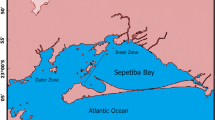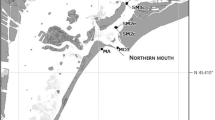Abstract
First year ontogenetic diet patterns and size-dependent diet partitioning of two coexisting piscivorous percids, pikeperch and Volga pikeperch were analysed in Lake Balaton. Diet patterns of the two pikeperches followed a common trend, catching larger preys at larger sizes, but in details they were different. Until 20–30 mm size age-0 pikeperch fed on planktonic microcrustaceans and were found only in the pelagic zone. After this size, from the end of May, a part of the stock shifted habitat and moved to the littoral zone to feed on Limnomysis benedeni. Majority of the stock stayed in the pelagic zone and shifted to Leptodora kindtii. In the pelagic group early piscivory, mainly cannibalism, occurred only sporadically. However, the few individuals that reached 100 mm size during the first year were typically piscivorous. Volga pikeperch stayed in the pelagic zone during the first year and shifted from planktonic microcrustaceans to benthic macroinvertebrates. General patterns of the first year diet ontogeny were similar in the different areas of Lake Balaton in both pikeperches with only some differences in the secondary food resources, especially in the share of chironomids. Chironomids were eaten at highest ratio by the two fish species in the Keszthely basin in accordance with their abundance pattern. Maximum prey sizes increased significantly with predator size in both pikeperch and Volga pikeperch. However, pikeperch ate much larger prey than did Volga pikeperch at the same size although they have a similar mouth gape to length ratio. These two, closely related pikeperches, although occur in the same habitat and have similar patterns of diet ontogeny, effectively partition food resources in Lake Balaton during the first growing season, except in the very beginning of their ontogeny at L = 5–10 mm size. It appears that age-0 Volga pikeperch is not a significant competitor for the economically highly rated pikeperch in Lake Balaton. On the other hand, it is age-0 pikeperch that might affect Volga pikeperch during its early ontogeny, in the planktivorous stage.
Similar content being viewed by others
References
A. C. Benke A. D. Huryn L. A. Smock J. B. Wallace (1999) ArticleTitleLength-mass relationships for freshwater macroinvertebrates in North America with particular reference to the southeastern United States Journal of the North American Benthological Society 18 308–343
P. Bíró (1972) ArticleTitleFirst summer growth of pike-perch (Lucioperca lucioperca L.) in Lake Balaton Annales Instituti Biologici (Tihany) 39 101–113
P. Bíró (1973) ArticleTitleThe food of pike-perch (Lucioperca lucioperca L.) in Lake Balaton Annales Instituti Biologici (Tihany) 40 159–183
P. Bíró (1977) ArticleTitleEffects of exploitation, introduction, and eutrophication on Percids in Lake Balaton Journal of the Fisheries Research Board of Canada 34 1678–1683
P. Bíró (1997) ArticleTitleTemporal variation in Lake Balaton and its fish populations Ecology of Freshwater Fish 6 196–216
P. Bíró L. Elek (1969) ArticleTitleThe spring and summer nutrition of the 300–500 g pike-perch (Lucioperca lucioperca L.) in Lake Balaton in 1968. I. Data bearing relation to the nutritional conditions proceedings the destruction of fish in 1965 Annales Instituti Biologici (Tihany) 36 135–149
P. Bíró L. Vörös (1990) ArticleTitleTrophic relationships between primary producers and fish yields in Lake Balaton Hydrobiologia 191 213–221 Occurrence Handle10.1007/BF00026054
P. Bíró S. E. Sadek G. Paulovits (1991) ArticleTitleThe food of bream (Abramis brama L.) in two basins of Lake Balaton of different trophic status Hydrobiologia 209 51–58 Occurrence Handle10.1007/BF00006717
A. Brabrand (2001) ArticleTitlePiscivory in larval perch (Perca fluviatilis): mechanisms structuring larval roach (Rutilus rutilus) cohorts Ecology of Freshwater Fish 10 97–104 Occurrence Handle10.1034/j.1600-0633.2001.100204.x
M. I. Bryazgunova (1979) ArticleTitleFeeding relationships of the young of the pike-perch, Lucioperca lucioperca, the bream, Abramis brama, and fishes of lesser importance in the lower reaches of the Don Journal of Ichthyology 19 57–65
A. D. Buijse R. P. Houthuijzen (1992) ArticleTitlePiscivory, growth, and size selective mortality of age 0 pikeperch (Stizostedion lucioperca) Canadian Journal of Fisheries and Aquatic Sciences 49 894–902
P. Byström L. Persson E. Wahlström (1998) ArticleTitleCompeting predators and prey: juvenile bottlenecks in whole-lake experiments Ecology 79 2153–2167
E. A. Campbell (1998) ArticleTitlePredation by small walleyes on yellow perch: effects of prey size distribution Transactions of the American Fisheries Society 127 588–597 Occurrence Handle10.1577/1548-8659(1998)127<0588:PBSWOY>2.0.CO;2
B. B. Collette M. A. Ali K. E. F. Hokanson M. Nagiec S. A. Smirnov J. E. Thorpe A. H. Weatherley J. Willemsen (1977) ArticleTitleBiology of the percids Journal of the Fisheries Research Board of Canada 34 1890–1899
P. Frankiewicz K. Dabrowski M. Zalewski (1996) ArticleTitleMechanism of establishing bimodality in a size distribution of age-0 pikeperch, Stizostedion lucioperca (L.) in the Sulejów Reservoir, Central Poland Annales Zoologici Fennici 33 321–327
L. G.-Tóth I. B. Muskó K. Szalontai P. Kiszely (2001) A nyíltvíz és a parti öv gerinctelen állatvilágának kutatása S. Mahunka J. Banczerowski (Eds) A Balaton kutatásának 2000. évi eredményei MTA Budapest 115–123
S. Hansson F. Arrhenius S. Nellbring (1997) ArticleTitleDiet and growth of pikeperch, Stizostedion lucioperca L in a Baltic See area Fisheries Research 31 163–167 Occurrence Handle10.1016/S0165-7836(97)00022-2
S. Herodek V. Istvánovics G. Jolánkai P. Csathó T. Németh Várallyay Gy. (1995) The P cycle in the Balaton catchment – A Hungarian case study H. Tiessen (Eds) Phosphorus in the Global Environment John Wiley and Sons Ltd 275–300
K. Holmgren M. Appelberg (2001) ArticleTitleEffects of environmental factors on size-related growth efficiency of perch, Perca fluviatilis Ecology of Freshwater Fish 10 247–256 Occurrence Handle10.1034/j.1600-0633.2001.100407.x
E. D. Houde (1997) Patterns and consequences of selective processes in teleost early life histories R. C. Chambers E. A. Trippel (Eds) Early Life History and Recruitment of Fish Populations Chapman and Hall London 173–196
T. A. Johnston R. A. Cunjak (1999) ArticleTitleDry mass-length relationships for benthic insects: a review with new data from Catamaran Brook, New Brunswick, Canada Freshwater Biology 41 653–674 Occurrence Handle10.1046/j.1365-2427.1999.00400.x
F. Juanes (1994) What determines prey size selectivity in piscivorous fishes? D. J. Stouder K. L. Fresh R. J. Feller (Eds) Theory and Application in Fish Feeding Ecology. Belle W. Baruch Library in Marine Sciences EditionNumber no. 18., University of South Carolina Press Columbia, SC 79–100
F. Juanes J. A. Buckel D. O. Conover (1994) ArticleTitleAccelerating the onset of piscivory: intersection of predator and prey phenologies Journal of Fish Biology 45: IssueIDSuppl. A 41–54
F. Juanes D. O. Conover (1994) ArticleTitleRapid growth, high feeding rates, and early piscivory in young-of-the-year bluefish (Pomatomus saltatrix) Canadian Journal of Fisheries and Aquatic Sciences 51 1751–1752
T. Kakareko (2002) ArticleTitleThe importance of benthic fauna in the diet of small common bream Abramis brama (L.), roach Rutilus rutilus (L.), pikeperch Sander lucioperca (L.) and ruffe Gymnocephalus cernuus (L.) in the Wloclawek reservoir Archives of Polish Fisheries 10 221–231
A. Kangur (2000) ArticleTitleFeeding of pikeperch, Stizostedion lucioperca (L.), in Lake Peipsi Proceedings of the Estonian Academy of Sciences Biology Ecology 49 98–108
K. Kawabata J. Urabe (1998) ArticleTitleLength-weight relationships of eight freshwater planktonic crustacean species in Japan Freshwater Biology 39 199–205 Occurrence Handle10.1046/j.1365-2427.1998.00267.x
Krebs C. J., 1989. Ecological Methodology. Harper and Row, New York
J. Lappalainen V. Erm J. Kjellman H. Lehtonen (2000) ArticleTitleSize-dependent winter mortality of age-0 pikeperch (Stizostedion lucioperca) in Parnu Bay, the Baltic Sea Canadian Journal of Fisheries and Aquatic Sciences 57 451–458 Occurrence Handle10.1139/cjfas-57-2-451
T. Mehner M. Plewa S. Hülsmann S. Worischka (1998) ArticleTitleGape-size dependent feeding of age-0 perch (Perca fluviatilis) and age-0 zander (Stizostedion lucioperca) on Daphnia galeata Archiv für Hydrobiologie 142 191–207
T. Mehner H. Schultz D. Bauer R. Herbst H. Voigt J. Benndorf (1996) ArticleTitleIntraguild predation and cannibalism in age-0 perch (Perca fluviatilis) and age-0 zander (Stizostedion lucioperca): Interactions with zooplankton, prey fish availability and temperature Annales Zoologici Fennici 33 353–361
G. L. Melnichuk (1973) ArticleTitleO kolichestvennoj ocenke pitaniya molodi sudaka Lucioperca lucioperca (L.) v Kremenchugskom vodokhranilische Voprosi Ikhtiologii 13 565–567
G. G. Mittelbach (1984) ArticleTitlePredation and resource partitioning in two sunfishes (Centrarchidae) Ecology 65 499–513
G. G. Mittelbach L. Persson (1998) ArticleTitleThe ontogeny of piscivory and its ecological consequences Canadian Journal of Fisheries and Aquatic Sciences 55 1454–1465 Occurrence Handle10.1139/cjfas-55-6-1454
M. Nagiec (1977) ArticleTitlePikeperch (Stizostedion lucioperca) in its natural habitats in Poland Journal of the Fisheries Research Board of Canada 34 1581–1585
R. A. Novitskij (1999) ArticleTitleEkologicheskaya kharakteristika bersha Stizostedion volgensis (Pisces, Percidae) Dneprovskogo vodokhranilishcha Vestnik Zoologii 33 63–72
M. H. Olson G. G. Mittelbach C. W. Osenberg (1995) ArticleTitleCompetition between predator and prey: resource-based mechanisms and implications for stage structured dynamics Ecology 76 1758–1771
M. E. Pelham C. L. Pierce J. G. Larscheid (2001) ArticleTitleDiet dynamics of the juvenile piscivorous fish community in Spirit Lake, Iowa, USA, 1997–1998 Ecology of Freshwater Fish 10 198–211 Occurrence Handle10.1034/j.1600-0633.2001.100402.x
L. Persson (1988) Asymmetries in competitive and predatory interactions in fish populations B. Ebenman L. Persson (Eds) Size-structured Populations: Ecology and Evolution Springer-Verlag Berlin 203–218
L. Persson L. A. Greenberg (1990) ArticleTitleJuvenile competitive bottlenecks: the perch (Perca fluviatilis) – roach (Rutilus rutilus) interaction Ecology 71 44–56
J. Peterka J. Maténa J. Lipka (2003) ArticleTitleThe diet and growth of larval and juvenile pikeperch (Stizostedion lucioperca (L.)): a comparative study of fishponds and reservoir Aquaculture International 11 337–348 Occurrence Handle10.1023/A:1025791208123
Podani J., 1994. Multivariate Data Analysis in Ecology and Systematics. SPB Publishing, The Hague
O. A. Popova L. A. Sytina (1977) ArticleTitleFood and feeding relations of Eurasian perch (Perca fluviatilis) and pikeperch (Stizostedion lucioperca) in various waters of the USSR Journal of the Fisheries Research Board of Canada 34 1559–1570
E. T. Schultz D. O. Conover (1999) ArticleTitleThe allometry of energy reserve depletion: test of a mechanism for size-dependent winter mortality Oecologia 119 474–483 Occurrence Handle10.1007/s004420050810
Specziár A., (2004). A fogassüllő és a kősüllő szaporulata a Balatonban. Halászatfejlesztés (in press)
A. Specziár P. Bíró (2003) ArticleTitlePopulation structure and feeding characteristics of Volga pikeperch, Sander volgensis (Pisces, Percidae), in Lake Balaton Hydrobiologia 506–509 503–510 Occurrence Handle10.1023/B:HYDR.0000008535.98144.1e
A. Specziár L. Vörös (2001) ArticleTitleLong term dynamics of Lake Balaton’s chironomid fauna and its dependence on the phytoplankton production Archiv für Hydrobiologie 152 119–142
A. Specziár L. Tölg P. Bíró (2000) ArticleTitleA Balaton halfaunájának vizsgálata Halászatfejlesztés 24 115–125
Sz. Szabó (2000) A Balaton nádasainak felmérése és minősítése L. Somlyódi J. Banczerowski (Eds) A Balaton kutatásának 1999. évi eredményei MTA Budapest 42–44
I. Tátrai J. Ponyi (1976) ArticleTitleOn the food of pike-perch fry (Stizostedion lucioperca L.) in Lake Balaton in 1970 Annales Instituti Biologici (Tihany) 43 93–104
I. Tölg (1959) ArticleTitleA balatoni fogassüllő ivadék (Lucioperca sandra Cuv. et Val.) táplálékának vizsgálata Annales Instituti Biologici (Tihany) 26 85–99
W. L. T. Densen ParticleVan (1985) ArticleTitlePiscivory and development of bimodality in the size distribution of 0+ pikeperch (Stizostedion lucioperca L.) Journal of Applied Ichthyology 3 119–131
W. L. T. Densen ParticleVan W. Ligtvoet R. W. M. Roozen (1996) ArticleTitleIntra-cohort variation in the individual size of juvenile pikeperch, Stizostedion lucioperca, and perch, Perca fluviatilis, in relation to the size spectrum of their food items Annales Zoologici Fennici 33 495–506
T. Vuille (1991) ArticleTitleAbundance, standing crop and production of microcrustacean populations (Cladocera, Copepoda) in the littoral zone of Lake Biel, Switzerland Archiv für Hydrobiologie 123 165–185
F. J. Ward B. R. McCulloch (1991) ArticleTitleRelationship between mouth gape of juvenile walley (Stizostedion vitreum vitreum) and prey size Verhandlungen Internationale Vereinigung für theoretische und angewandte Limnologie 24 2362–2364
E. E. Werner (1986) Species interactions in freshwater communities J. Diamond T. Case (Eds) Community Ecology Harper and Row New York 344–358
E. E. Werner J. F. Gilliam (1984) ArticleTitleThe ontogenetic niche and species interactions in size-structured populations Annual Reviews of Ecology and Systematics 15 393–425 Occurrence Handle10.1146/annurev.es.15.110184.002141
J. Willemsen (1977) ArticleTitlePopulation dynamics of percids in Lake IJssel and some smaller lakes in the Netherlands Journal of the Fisheries Research Board of Canada 34 1710–1719
Author information
Authors and Affiliations
Corresponding author
Rights and permissions
About this article
Cite this article
Specziár, A. First Year Ontogenetic Diet Patterns in Two Coexisting Sander Species, S. lucioperca and S. volgensis in Lake Balaton. Hydrobiologia 549, 115–130 (2005). https://doi.org/10.1007/s10750-005-5766-x
Received:
Revised:
Accepted:
Issue Date:
DOI: https://doi.org/10.1007/s10750-005-5766-x




